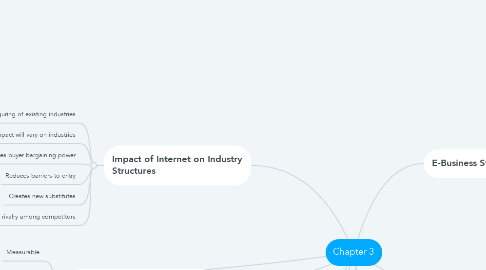
1. Impact of Internet on Industry Structures
1.1. Re-configuring of existing industries
1.2. Impact will vary on industries
1.3. Increases buyer bargaining power
1.4. Reduces barriers to entry
1.5. Creates new substitutes
1.6. Intensifies rivalry among competitors
2. Co-opetition framework
2.1. Firm
2.1.1. Competitors
2.1.1.1. Supplier
2.1.1.2. Buyer
2.1.2. Complementors
2.1.2.1. Supplier
2.1.2.2. Buyer
3. A market segment should be:
3.1. Measurable
3.2. Substantial
3.3. Differentiable
3.4. Actionable
4. Segmentation Type
4.1. Geographic segmentation
4.1.1. Geographic regions (e.g. continents, countries, states)
4.2. Demographic segmentation
4.2.1. Age, gender, income, life style
4.3. Psychographic segmentation
4.3.1. Personality type and personal interests (e.g. cash-rich, time-poor)
4.4. Behavioural segmentation
4.4.1. Purchasing frequency, usage patterns, etc.
5. E-business market segmentation matrix
5.1. Buyer/recipient
5.1.1. Consumer/peer/citizen
5.1.2. Business
5.1.3. Government
5.2. Supplier/provider
5.2.1. Consumer/peer/citizen
5.2.2. Business
5.2.3. Government
6. E-Business Strategy
6.1. Strategic Analysis
6.1.1. Opportunities/threats Strengths/weaknesses
6.1.1.1. External Analysis
6.1.1.2. Internal Analysis
6.1.1.3. Strategy Formulation
6.1.1.3.1. Strategy Options
7. Industry and Macro Environment
7.1. Customers, Company, Competitors
7.1.1. Economic Environment
7.1.2. Legal & Political Environment
7.1.3. Technological Environment
7.1.4. Social Environment
7.1.5. Natural Environment
8. Five Forces Model
8.1. Industry Competition
8.1.1. Potential Entrants
8.1.2. Suppliers
8.1.3. Buyers
8.1.4. Substitutes
8.2. Rivalry among existing competitors
8.2.1. Barriers to entry
8.2.2. Bargaining power of suppliers
8.2.3. Threat of substitute products or services
8.2.4. Bargaining power of channels and end users
